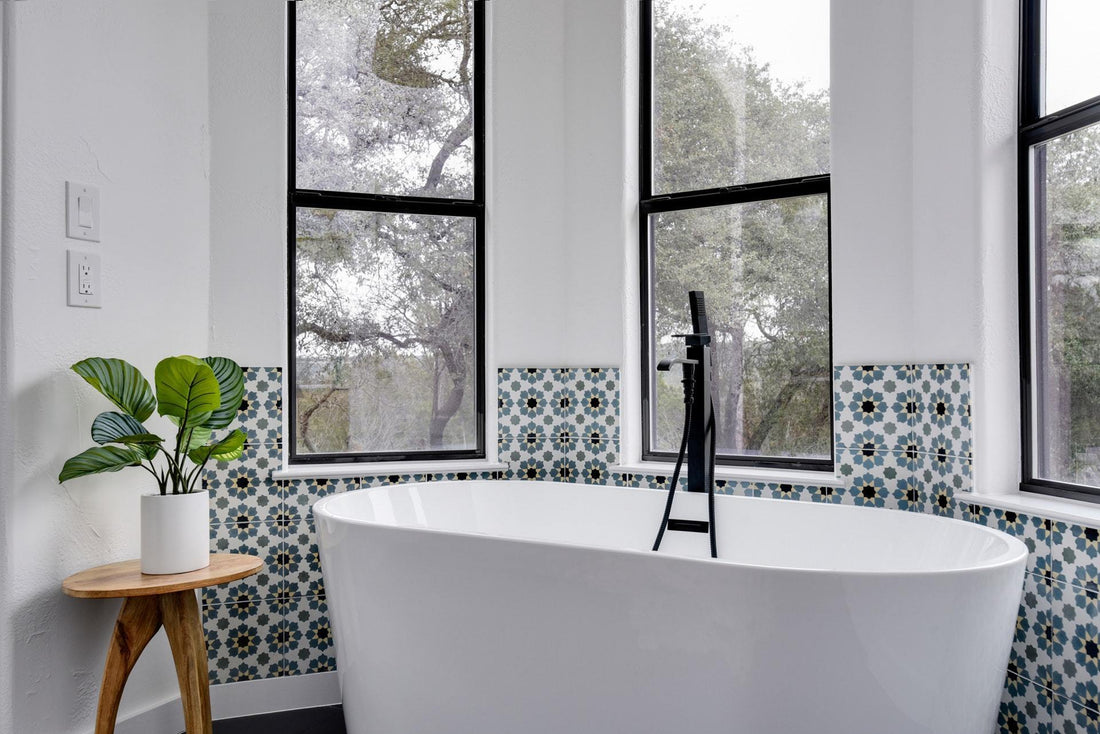
Let’s Talk Cement Tile
Share
Chances are, you have admired cement tile for quite some time now. Being fashionable since the 19th century in Europe, the Middle East, Asia, and Latin America, cement tiles have arrived into homes, restaurants, hotels, and other thoughtfully designed spaces all over the United States. We know cement tiles for vibrantly colored patterns or subtly elegant soft neutrals. With their myriad of customization options, cement tiles have the remarkable ability to morph from style to style and color way to color way, making them a staple in the interior design world for centuries.
Our cement tile boasts carefully crafted responsibly-sourced materials and eco-friendly day-to-day production processes.


The Look
Cement tile has just the right amount of distress that it provides a distinguishable and often beloved character. The surface of these tiles is matte, silky, and cooling. You can even enhance the semi-gloss sheen finish through a penetrating sealer. These tiles are great for those wanting a unique look. If you choose cement tile, make sure you appreciate materials that age. Cement tiles will inevitably show hairline fractures and fading. Expect cement tile to patina. Because each tile absorbs a differing amount of sealer, cement tiles may darken differently. For these reasons, this product will never look the same as they first did out of the box. If your design tendency is to incorporate surfaces that age with time, cement tile is for you.

The Specs
The most common size of a cement tile is a 8”x8” square or 8” Hexagon. The thickness is about 5/8 inches, mainly because cement tiles are composed of several layers.

Where can I install cement tiles?
For centuries, cement tiles have adorned historic homes and architectural masterpieces around the world. They recently found their way into the homes of many design aficionados enamored with the trend of sustainable pattern tiles. Cement tile makes sense in both indoor and outdoor spaces. It adds much character to any room, even showers, if sealed correctly.

How is it made?
Our cement tiles don’t use glazes or kilns. Instead skilled tile makers create these beautiful cement-based surface products 100% pollution free. Made by hand since the 19th century, cement tiles manufacturing includes the use of mineral pigments, cement, a metal mold, and a hydraulic press. The pigment composition is a mixture of high quality white Portland cement, marble powder, fine sand, and natural mineral color pigments.

To create the pattern, artisans weld steel molds (think something similar to an oversized cookie cutter). Then, they carefully fill the mold by pouring natural pigmented colors into each of the mold’s sections. Once all sections are filled, artisans remove the mold and quickly add layers of the white Portland cement mix to not let the colors run into each other. Finally, a hydraulic press applies pressure evenly until the layers become a single tile. Then, artisans carefully submerge the tile in water causing the necessary chemical reaction in the concrete to harden. Once this occurs, the tiles are removed from the water, allowed to dry and stacked for proper curing time.
Installation
We recommend that professional tile installers execute handmade tile installations. Also, please keep in mind that before, after, and during a cement tile installation, each and every piece needs to be sealed. This will protect the tiles from absorbing moisture and enhance its sheen. The most common problems associated with cement tile installation are insufficient or inadequate sealing, and grout pigment staining. Read our sealing guidelines here. Moreover, cement tile installation is typically more time-consuming and labor intensive than a clay or ceramic tile installation. Please read our encaustic pattern cement installation guidelines carefully and provide to your contractor/installer.

Cement Tile Characteristics in a nutshell
- Bold designs, vibrant colors or elegant neutrals
- A myriad of available customizable patterns
- 100% handmade
- Eco-friendly, made from 100% natural pigments and materials
- 100% Recyclable
- Very durable
- They age like your favorite pair of jeans and develop a patina over time.
- Sealing and regular re-sealing is required to minimize staining